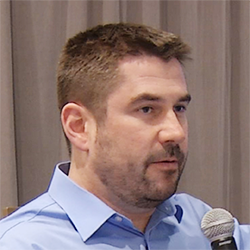Home » Dysautonomias » Live Demonstration Autonomic Function Tests Part 3: Valsalva Maneuver with Patient Jade
Live Demonstration Autonomic Function Tests Part 3: Valsalva Maneuver with Patient Jade
In this video Dr. Singer and Mr. David Sletten demonstrate how to conduct a Valsalva maneuver with a patient.
Mr. David Sletten: So, I’ll go ahead, and I’ll explain to Jade what we want him to do for this test.
Toni: I’m just going to have him move his feet up a couple of inches – you don’t want them pushing their feet against the floorboard. You want to keep their muscles fully relaxed and use their tummy muscles.
Mr. Sletten: So, I’ll go ahead and explain what I wanted to do. So, this next exercise is a blowing exercise, what I’m going to ask that you do is take a big deep breath in like you are blowing up a balloon. Once you get that breath go ahead and put that bugle on your mouth and start to blow out. Once you blow out there’s going to be a little line here that moves up that 40. I want you to hold it there for 15 seconds. There will also be a little timer up here that’s counting down for you, so you know where you’re at, at all times. Any questions?
Toni: And again, you want your feet muscles and toes not pushing against the floorboard and also tell him to keep this arm relaxed. A lot of people will because it is hard to do and if they start bearing down over here in the…
Dr. Wolfgang Singer: Or making a fist.
Toni: Yeah, it’s like blowing a huge beach ball or air mattress and like (mimics hard time breathing). And another thing they’ll do too is when you say, “Okay, blow”, it’s all of a sudden, their head comes up and their doing a crunch and so those are the three things. And tell them not to talk after they get done because that is the first thing, they want to do is cough.
Dr. Singer: That one’s really hard, (laughing).
Mr. Sletten: Or your POTS patients, “I feel lightheaded, I feel dizzy” (laughing).
Mr. Sletten: Okay so Jade whenever you’re ready go ahead take that nice big deep breath in and just begin.
Toni: Okay, we are holding up for 15 seconds.
Mr. Sletten: So, you can see up there we have got timer up at the top that started there. Jade has a timer up here that started as well for him and go ahead and relax, just breathe like you normally would, try not to say anything. This next 30 seconds is the most important for our measurement of that Valsalva ratio. And this is another thing that’s done just a little bit differently if you’re looking at some of the slides that have come out of the Mayo or any of the literature. We actually make 3 marks not just the 2, we make one when we ask the patient to take a big deep breath in. You’ll see that there’s a little bit of change that happens with that and then we don’t make that second mark until they hit at least 20 mmHg and that’s when our timer starts. So, we don’t start that timer as soon as they start blowing, it’s once they are above 20. Some of the other things that are really important is we don’t want them going from 40 to 20 to 40 to 20. We really want them to get up to a steady pressure and to hold it there and so that’s some of the stuff that we’re looking at as technicians to be sure that they are doing a steady pressure. If for any reason they couldn’t maintain 40, this is when we would say on the next one just go to 30 this next time and hold it there. There are settings that you can change that within the software but normally we don’t have the luxury of all these automatic markings for us, so we make them ourselves.
Dr. Singer: An example of a flat top response, you see there’s really not looking at mean blood pressure, there’s really no drop below baseline. We would normally now tilt them up to 20 and then subsequently 40 degrees to induce more of a blood pressure change, you can see his heart rate did change but there wasn’t a dramatic rise in heart rate and that could almost be an abnormal Valsalva ratio now because he has a flat top response configuration. Now, we don’t have the luxury to have a tilt table here unfortunately so option is we just do another one supine, or we do one sitting, you can try that.
Toni: Sure, let’s do that. Okay, so we are going to have him put his arm over here across your chest, okay. We have even done standing so you need to be careful because somebody’s…
Dr. Singer: Perfect.
Toni: Feet flat, make sure their legs aren’t crossed.
Dr. Singer: Again, you want to wait until there’s a nice baseline again and then we’ll give it try.
Mr. Sletten: Normally we would wait the 3 minutes before we do anything to make sure everything stabilizes.
Toni: Okay, one nice big deep breath and blow it up to that 40.
Mr. Sletten: So, for those in the screen at the bottom you can see where the pressure is in the 40 down there.
Toni: And stop, just relax, we’re monitoring your blood pressure for the next couple of minutes.
Dr. Singer: So, you can see the difference is more clearly developed phases, you have an actual early phase two, may actually see a late phase two developing here. Doesn’t have much of an overshoot but again is still almost the blood pressure did not really go much below baseline so really, he needs an even stronger stimulus, so really standing might be ideal but I don’t think we’ll do that for the purpose of time.
Mr. Sletten: So, we’ve got enough time for what we need to do our assessment, so I am going to go ahead and stop this.
Dr. Singer: So, you look at the systolic blood pressure for pressure recovery time and as you can see this is phase 3 here at this point, he is already above baseline so his PRT is basically 0, right. If anything, you give him one second, he is clearly above so he doesn’t really have much of an overshoot again because it wasn’t much of a drop before. This is as normal as it gets.

Wolfgang Singer, MD
Associate Professor of Neurology
Mayo Clinic Rochester, MN































